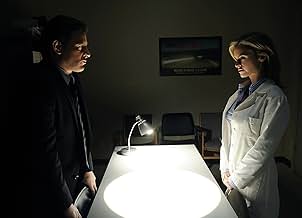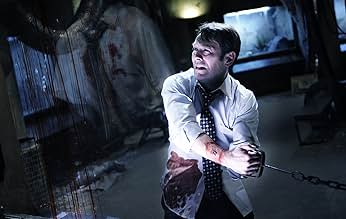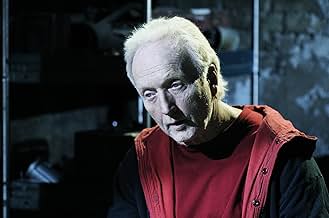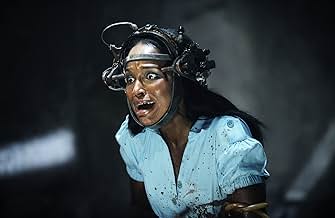Special Agent Strahm ist tot und Detective Hoffman der unumstrittene Erbe von Jigsaws Vermächtnis. Als das FBI jedoch die Schlinge enger um Hoffman zieht, setzt der das teuflische Spiel wied... Alles lesenSpecial Agent Strahm ist tot und Detective Hoffman der unumstrittene Erbe von Jigsaws Vermächtnis. Als das FBI jedoch die Schlinge enger um Hoffman zieht, setzt der das teuflische Spiel wieder in Gang. Nach und nach wird Jigsaws großer Plan immer deutlicher...Special Agent Strahm ist tot und Detective Hoffman der unumstrittene Erbe von Jigsaws Vermächtnis. Als das FBI jedoch die Schlinge enger um Hoffman zieht, setzt der das teuflische Spiel wieder in Gang. Nach und nach wird Jigsaws großer Plan immer deutlicher...
- Regie
- Drehbuch
- Hauptbesetzung
- Auszeichnungen
- 2 Nominierungen insgesamt
Empfohlene Bewertungen
The very first thing I noticed that was different was the pacing of the movie. The opening scene is a trap. I will not reveal who, or why for that matter, you pay good money to find out after all. Though after that, the movie takes a very different tone. While everyone probably is used to the nature of SAW not wasting any time, they took a different approach for the sixth installment.
We begin to follow where SAW V left off, Hoffman emerging victorious, or so it may seem. And soon enough, the introduction of our newest test subject, William. It's hard to get into the character without spoiling anything, so if I seem vague, you know why. William is an insurance agent, the vice president of his company as a matter of fact. In that, he made a formula on how to determine who should be eligible for health insurance. Needless to say, John Kramer was a former associate of his.
Jill, the ex-wife of the infamous Jigsaw Killer was also presented a box. The box plays a large role this time around and again, I will not spoil it. Her role in the grand scheme of things is further explained and finally understood. Everything between her past with John, her present with Hoffman, and if she truly is part of the scheme, or just another person wanting to escape it all.
The story is nice refresher from the original pace and nicely executed. Acting this time around as well was great.
My only complaint is how even though the ending will surprise you, there has been so much exposed through previous installments, you feel less than shocked. Those who remember previous SAW's will understand what I mean by shock.
There is a lot answered this time around, near everything actually. Be it the letter from SAW III, Hoffman's true intentions, Jill's involvement, and Jigsaw's grand scheme, everything will be fully explained this time around. I highly recommenced this SAW, especially if you want to give it that one last chance to see if it can be saved. Personally, I find it redeeming and if they continue with refreshing courses such as this, SAW could go on forever.
There were a couple of great twists and turns, the gore was jacked up to a fantastic level of brutal extremity (easily beating the rather tame 5th installment), and most importantly, I, plus everyone in the theatre had a ball with it.
As well as being a valid continuation of the 'Saw' story, it worked well as a standalone film. The main twist actually had nothing do to with the previous movies... but don't get me wrong, you'll get plenty of answers for questions left open from the other films at the same time.
As you'd expect, the acting and production values weren't to flash, but the good screenplay and balls-out sadistic torture made this a vast improvement over the last couple of sequels. Apart from the first, I'm happy to say this is definitely one of my favorites from the series. 7.5/10.
Check it out. I found it to be a pleasant surprise.
The series continues to improve with Part VI, which develops the Hoffman character further, ladles on even more revolting splatter, and steadfastly refuses to get bogged down with trifling matters such as the cash, time, and skill required to build such amazing methods of torture. Part VI simply gets on with entertaining the fans, with a twisty-turny narrative and bucket-loads of the red stuff.
This time around, Jigsaw has assembled a group of despicable life-insurance business-people, and proceeds to teach them that choosing between life and death should not be an easy decision to make. As a result, bodies are blasted, crushed, hung, and, in the film's most revolting scene, melted from the inside with a highly corrosive acid. Meanwhile, the F.B.I. are closing in on Hoffman, although Kramer's wife Jill Tuck (Betsy Russell) also has a surprise in store for the deviant agent. Rather surprisingly, this satisfyingly sick chapter has left me looking forward to more Saw.
7.5/10, rounded up to 8 for IMDb.
Saw 6 reignited my interest in the franchise, I thought 4 and 5 were no more than average, they both felt as though they'd been churned out simply to fill a gap and pick up a few easy bucks, Saw 6 however had a real streak of cleverness.
Looking back now this seemed to lay the ground work for the likes of Saw X and Jigsaw, with better storytelling, more twists and turns, and the usual gore, but it didn't simply rely on the latter, there really was a good bit of storytelling here.
I can't say I truly followed the Hoffman sequences, and to he honest I didn't find them totally interesting, the story of the dodgy executive however, was great, and some of those games were highly imaginative and brutal, not sure I'll ever forget the roundabout of death.
This was much improved over 4 and 5.
7/10.
Saw VI starts with a bang. You know right off the bat that this isn't the same dead serious almost somber type of Saw film you're used to. I'm going to give Greutert and company the benefit of the doubt here and assume that this is by design. You know when Jigsaw is putting people in traps for smoking too much that your tongue should be firmly planted in cheek. This film is also much more open and colorful than previous films. After the claustrophobic Saw V that seemed to take place in only three different rooms this is a welcome change of pace. Also the traps here are much more inventive than V and maybe even IV (nothing will best III in my mind for sheer over the top-ness). The amount of twists and surprises is also plentiful and really do help bring the game full circle. This is definitely not the transition film that the last one was and it really left me to wonder where exactly they can go from here. The twists and turns of the plot are not something I want to give away as its part of the fun but suffice to say if you've stuck with the series up until now you won't feel gipped as you walk out of the theater. The film follows Hoffman as he tries to stay one step ahead of the FBI while conducting a game involving John Kramer's insurance broker William who is put through a series of tests involving his co-workers. The film moves at a breakneck pace cutting back and forth between the two main plot threads while also throwing in the now famous Saw flashbacks to fill in the gaps of all the past movies. I was never bored and special mention has to be given to Greutert for really keeping this thing from getting bogged down in the procedural aspects that really plagued the last few films. This is balls to the wall entertainment and it delivers while also winking and nodding along the way. Saw also gets extremely topical here for the first time and the main thrust and theme of this film will hit home to anyone who even has a passing knowledge of current affairs in this country.
The only negatives I can really point out in the film is some of the suspect acting but again this might be done on purpose through the director's eyes to inject some humor without resorting to having Jigsaw or Hoffman crack jokes Freddy Krueger style while they dispense moral justice. We haven't gotten there yet, maybe Saw X. The other problem I had was that some of the back story really pushed the suspension of disbelief but I guess I shouldn't nit-pick because that has been a problem as far back as Saw II and is needed to stretch out this far anyway.
All in all this is easily the best Saw since the 2nd one and I am glad to see the series get back on track after the CSI elements of the last two films. This is Saw how I like it: down and dirty and over the top. Bring on Saw VII!
Wusstest du schon
- WissenswertesDirector Kevin Greutert mentioned in the commentary track that the twitching and shivering Amanda (Shawnee Smith) does in her scenes with Cecil (Billy Otis) was real due to low temperatures and rain in Toronto at the time of filming. Shawnee couldn't stop shivering because she was cold and they were shooting outdoors.
- Patzer(at around 19 mins) When the coroner, Dr. Adam Heffner, is talking to Hoffman and Agent Dan Erickson and Agent Lindsey Perez, he says that the knife used to remove the jigsaw piece from Eddie had a partially serrated edge. Dr. Heffner then claims that same knife was used to cut the jigsaw piece from Seth Baxter. However, in Saw V (2008) the knife used to remove the jigsaw piece from Seth Baxter is a non-serrated scalpel, not the "knife with a partially-serrated edge" that Dr. Heffner claims was used.
- Zitate
Jigsaw: [flashback scene when John questions William about being denied coverage for his cancer treatment] I came to talk to you Will, because I've found a treatment for my cancer that I think holds a lot of promise, but my requests for coverage have all been turned down.
William: Yeah...
Jigsaw: So, I was hoping that if I came and explained it to you that you might be able to get that overturned for me.
William: [smiles doubtfully] Well, the buck stops here, John. Fire away.
Jigsaw: Okay.
[John hands William a brochure]
Jigsaw: This is a doctor in Norway. He's got a 30 to 40% success rate with gene therapy. He injects what he calls suicide genes into cancerous tumor cells; then an inactive form of a toxic drug is administered...
William: Yes. I'm familiar with the therapy you're talking about.
Jigsaw: Right. And a new trial's starting. He's looking for new patients and he seems to think that I'm the perfect candidate...
William: John, if your primary physician, Dr. Gordon, thought you were a suitable candidate, he would have pursued it.
Jigsaw: No. Dr. Gordon is a specialist. You know, he's making money on his specialty. He's not a thinker. I mean, the man has his hand on the doorknob half the time that I'm there.
William: I'm gonna be straight with you. At your age and with the development of your cancer, it's simply not feasible for Umbrella Health...
Jigsaw: Wait, wait, wait, wait. What's not feasible? By whose mathematical equation is this not feasible?
William: It's policy, John. It's policy.
[pause]
William: And if you go outside the system and seek out this treatment, which has been deemed ineffective, you will be in breach of policy and you will be dropped from coverage completely.
[pause]
William: I'm sorry.
Jigsaw: [gets up from his chair and paces around William's office] Did you know that in the Far East, people pay their doctors when they're healthy? When they're sick, they don't have to pay them. So basically, they end up paying for what they want, not what they don't want.
[pause]
Jigsaw: We got it all ass-backwards here. These politicians, they say the same thing over and over and over again; "Healthcare decisions should be made by doctors and their patients, not by the government." Well, now I know they're not made by doctors and their patients or by the government. They're made by the fucking insurance companies.
- Crazy CreditsSPOILER: In the Unrated Edition, there's an extra scene after the end credits: Amanda comes to the door of the place holding Corbett Denlon (Jeff Denlon's daughter, who Hoffman "saves" at the beginning of Saw V (2008)) and warns her "not to trust the one who saves her".
- Alternative VersionenAlso available in an unrated director's cut version, which restores deleted scenes and the violence originally cut for an "R" rating. A new scene after the end credits is also added.
- VerbindungenEdited from Saw V (2008)
- SoundtracksMore Than a Sin
Written and Performed by The James Brothers
Courtesy of James Bro. Music
Copyright 2008
Top-Auswahl
Details
Box Office
- Budget
- 11.000.000 $ (geschätzt)
- Bruttoertrag in den USA und Kanada
- 27.693.292 $
- Eröffnungswochenende in den USA und in Kanada
- 14.118.444 $
- 25. Okt. 2009
- Weltweiter Bruttoertrag
- 68.234.154 $
- Laufzeit
- 1 Std. 30 Min.(90 min)
- Farbe
- Sound-Mix
- Seitenverhältnis
- 1.85 : 1













































